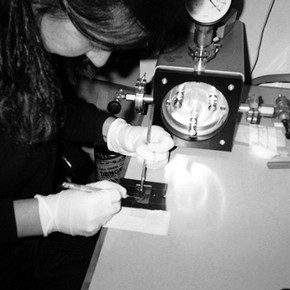Conservation Journal
Spring 2000 Issue 34
Difficulties In The Scientific Study of Synthetic Materials In Paints

Figure 1. Preparing samples for PyGCMS. Photograph by Fotini Koussiaki (click image for larger version)
The scientific study of artists' materials in painting covers a wide range of subjects. Although paints contain many compounds (extenders, additives, etc.), those most investigated are pigments and binders. Indeed, a lot of literature is available regarding the chemistry of traditional binders used by artists, in particular oils. However, little has been documented about the various synthetic materials which have been introduced throughout the 20th Century1.
The first synthetic paints were house paints and industrial coatings and it was in these forms that artists first used them. These synthetic materials display a lot of useful properties: quick drying time, transparency, high flexibility, good adhesion, resistance to chemicals, stability to thermal stress, light and UV radiation. House paints are cheap compared to artists' products, and can give particular visual effects. It is useful to keep in mind that companies formulate house paints for completely different purposes and they are likely to be more vulnerable to deterioration than artists' quality paints.
It is thought that in 1932 the artist David Alfaro Siqueiros [Mexico, 1896 - 1974] used for the first time a synthetic binder - ethyl silicate - for his paintings. Introducing modern materials, Siqueiros together with Morris Louis [USA, 1912 - 1962], Jackson Pollock [USA, 1912 - 1956] and other artists had to develop new methods of paint application, such as spray guns and airbrushes. The introduction of synthetic resins was one of the most important revolutions in the history of painting2.
Nowadays, there are three classes of resins mainly utilised for paint. These are poly(vinylacetates) or PVAs, acrylic resins and alkyd resins. Alkyds have been the principal binder in oil-based housepaint since the 1950s. PVAs and acrylics, although initially resin-in-solvent formulations, were sold as emulsions from the 1960s, which became much more commercially successful.
It might be thought that it is easier to study modern materials than old materials because one can still buy the products being studied and compare them with paints found on artworks. This is not entirely true. It is known that Picasso [Spain, 1881 - 1973] used a French product named Ripolin in some of his paintings. If one searches for this paint on the web, one finds that a Spanish company now produces Ripolin. Is this company the same? In all these years has the same paint composition been maintained? In investigating the composition of these resins, one has to cope with the problem that if the products are still on sale, companies are very reluctant to give information about them, and if the products are no longer available, companies do not always keep records.
One of the most obvious approaches to the study of modern materials is to interview those artists who used them. Unfortunately, not all of the artists are still alive and, even when they are, what they remember is not always what they actually did.
In order to study the chemistry of synthetic resins the most common technique is Fourier transform infrared spectroscopy (FTIR). FTIR is normally used as a comparative technique with the spectrum of each unknown material being matched either visually with a library of known standards or through a computer-generated search. Another useful technique is pyrolysis gas chromatography mass spectrometry (PyGCMS). Pyrolysis (breaking down the paint medium into smaller molecules by heat) is necessary because of the high molecular weight of the resins involved (Figure1).
Both FTIR and PyGCMS help to establish the type of synthetic resin being studied. Both techniques have been very useful in investigating acrylic paints; however they provide little information on alkyds and PVAs. In general, these two techniques provide no detailed information about the components of chemically complicated structures like alkyds. Consequently, some conservation scientists involved in modern materials have realised that it is imperative to find new techniques which can give more details about alkyds and PVAs. This is the gap that my research project on the RCA/V&A Conservation programme, supervised by the Tate Gallery conservation scientists, would like to fill.
References
Resources
Spring 2000 Issue 34
- Editorial - A New Look For The Conservation Journal
- Contemporary V&A
- Twenty First Century Conservation
- Science Surgery: The Contemporary Challenge
- Masters Not Slaves - New Technology In The Service Of Conservation
- Difficulties In The Scientific Study of Synthetic Materials In Paints
- SIGGRAPH 99, Or Why A Conservator Should Attend A Graphics Conference
- 'My Picture Is A Sum Of Destructions', Pablo Picasso (1881-1973)
- Printer Friendly Version